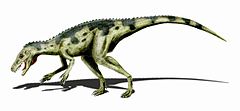Herrerazaury
| Herrerasauria | |
| Galton, 1985 | |
 rekonstrukcja Herrerasaurus ischigualastensis | |
| Systematyka | |
| Domena | |
|---|---|
| Królestwo | |
| Typ | |
| Podtyp | |
| Gromada | |
| Podgromada | |
| Infragromada | |
| Nadrząd | |
| Rząd | |
| Podrząd | teropody (?) |
| Infrarząd | herrerazaury |
Herrerazaury (Herrerasauria) - infrarząd obejmujący jedne z najstarszych znanych dinozaurów. Nazwę dla kladu ukuł paleontolog Peter Galton w 1985 r, lecz dopiero Langer (2004)[1] zaproponował dla niego definicję (wszystkie dinozaury mające bliższego wspólnego przodka z herrerazaurem niż liliensternem i plateozaurem). Sereno (2005)[2] uważa tak definiowane Herrerasauria za młodszy synonim rodziny Herrerasauridae sensu Sereno, 1998[3].
Żyły w okresie triasu (ok. 228-225 mln lat temu) głównie na terenach współczesnej Ameryki Południowej (Brazylia, Argentyna); przedstawicielem grupy może być ponadto północnoamerykański czindezaur. Niedźwiedzki i współpracownicy (2014) opisali europejskiego przedstawiciela grupy na podstawie skamieniałości odkrytych w Polsce[4]. Długość ciała 2-4 m, wysokość ok. 1 m, masa do 100 kg.
Pierwsze analizy kladystyczne sugerowały, że herrerazaury są bazalnymi dinozaurami nie należącymi ani do Saurischia ani do Ornithischia[5][6]. Odkrycie nowych skamieniałości herrerazaura, w tym czaszki, w 1988 r. dało dodatkowy materiał do badań i porównań. Mimo to analizy kladystyczne z ostatnich lat dają różne rezultaty, a pozycja systematyczna herrerazaurów pozostaje przedmiotem sporów. Obecnie wśród naukowców najbardziej popularne są dwie koncepcje: według pierwszej herrerazaury są bazalnymi teropodami, nie należącymi do bardziej zaawansowanych ewolucyjnie neoteropodów[7][8], według drugiej - bazalnymi dinozaurami gadziomiednicznymi, nie należącymi do bardziej zaawansowanego ewolucyjnie kladu Eusaurischia, obejmującego teropody i zauropodomorfy[1][9][10]. Według analizy Nesbitta (2011) Staurikosaurus i Herrerasaurus były bazalnymi teropodami; nie tworzyły one kladu, lecz były sukcesywnie bardziej odległymi grupami zewnętrznymi w stosunku do kladu obejmującego neoteropody i rodzaje Eoraptor oraz Tawa. Gdy jednak w analizie kladystycznej nie uwzględniano rodzaju Tawa, Staurikosaurus i Herrerasaurus znajdowały się w nierozwikłanej politomii z zauropodomorfami oraz z kladem obejmującym neoteropody i eoraptora[11].
Klasyfikacja herrerazaurów:
Herrerasauria
- Rodzina: Staurikosauridae
- staurikozaur (Staurikosaurus)
- Rodzina: Herrerasauridae
- czindezaur (Chindesaurus)
- herrerazaur (Herrerasaurus)
- ?kaseozaur (Caseosaurus)
← mln lat temu Herrerazaury | ||||||||||||
| ←4,6 mld | 541 | 485 | 443 | 419 | 359 | 299 | 252 | 201 | 145 | 66 | 23 | 2 |
Przypisy
- ↑ a b Langer, M. C. (2004) "Basal Saurischia." Pp. 25–46 in Weishampel, D.B., Dodson, P., and Osmólska, H. (eds.). The Dinosauria, Second Edition. University of California Press, Berkeley, 861 pp.
- ↑ Sereno, P. C. 2005. Stem Archosauria—TaxonSearch [version 1.0, 2005 November 7]; Taxon Search - Herrerasauria
- ↑ P. C. Sereno (1998) "A rationale for phylogenetic definitions, with application to the higher-level taxonomy of Dinosauria." Neues Jahrbuch für Geologie und Paläontologie, Abhandlungen 210 (1):41-83
- ↑ Grzegorz Niedźwiedzki, Stephen L. Brusatte, Tomasz Sulej i Richard J. Butler. Basal dinosauriform and theropod dinosaurs from the mid–late Norian (Late Triassic) of Poland: implications for Triassic dinosaur evolution and distribution. „Palaeontology”, 2014. DOI: 10.1111/pala.12107. (ang.).
- ↑ Gauthier, J. A. (1986) "Saurischian monophyly and the origin of birds." In: Padian, K (ed.) The Origin of Birds and the Evolution of Flight Memoirs of the California Academy of Sciences 8:1-55
- ↑ Brinkman, D. B. & Sues, H.-D. (1987) "A staurikosaurid dinosaur from the Upper Triassic Ischigualasto Formation of Argentina and the relationships of the Staurikosauridae." Palaeontology 30(3):493-503
- ↑ Sereno, P. C. (1999) "The evolution of dinosaurs." Science 284:2137-2147
- ↑ Rauhut, O. W. M. (2003) "The interrelationships and evolution of basal theropod dinosaurs." Special Papers in Palaeontology 69:1-213
- ↑ Langer, M. C. & Benton, M. J. (2006) "Early dinosaurs: a phylogenetic study." Journal of Systematic Palaeontology 4(4):309-358 DOI:10.1017/S1477201906001970
- ↑ Ezcurra, M. D. (2006) "A review of the systematic position of the dinosauriform archosaur Eucoelophysis baldwini Sullivan & Lucas, 1999 from the Upper Triassic of New Mexico, USA." Geodiversitas 28(4):649-684
- ↑ Sterling J. Nesbitt. The early evolution of archosaurs : relationships and the origin of major clades. „Bulletin of the American Museum of Natural History”. 352, s. 1–292, 2011. (ang.).
Media użyte na tej stronie
Autor:
- derivative work: Dinoguy2 (talk)
- Spinosaurus_BW.jpg: ArthurWeasley
Spinosaurus aegyptiacus, a spinosaurid from the Middle Cretaceous of Egypt
Autor: Nobu Tamura (http://spinops.blogspot.com), Licencja: CC BY 2.5
Herrerasaurus ischigualastensis, pencil drawing after skeletal by C. Abraczinskas and P. Sereno; see [1], details of the skull at [2] and of the hands and feet at [3]


